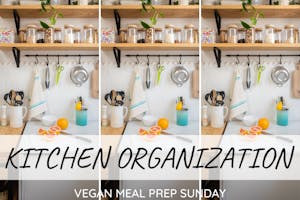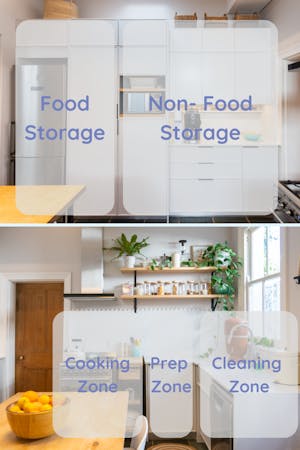Creating an efficient kitchen is about more than just having the latest gadgets or the most spacious countertops—it’s about organization. By strategically arranging your kitchen into specific zones, you can streamline your workflow, save time, and make cooking an enjoyable experience.

Organize your kitchen into zones to maximize efficiency and save time. Designate areas for food storage, non-food items, prep, cooking, and cleaning. This method streamlines your workflow, making meal prep and cleanup quicker and easier. Tailor the zones to your space and cooking habits for the best results. A well-organized kitchen enhances your cooking experience, making it more enjoyable and productive.
In this guide, I’ll walk you through how to organize your kitchen by zones, helping you maximize both efficiency and space.
Table of Contents

1. Food Storage Zone
The food storage zone is the heart of your kitchen, encompassing your fridge, freezer, and pantry. Keeping this zone organized is crucial for meal planning and cooking efficiency.
Refrigerator and Freezer: Start by organizing your fridge and freezer by food type. Designate specific areas for fruits and vegetables, dairy alternatives, prepared meals, and leftovers. For instance, keep all your plant-based dairy products like almond milk and vegan cheese together. Use clear bins to group similar items, making it easier to find what you need and reducing food waste. Label shelves and bins to remind yourself where things belong, helping maintain order over time.
Related post: The Ultimate Guide to a Vegan Fridge: What to Stock and How to Organize
Pantry: A well-organized pantry is a game-changer. Sort your pantry items into categories, such as canned goods, grains, and snacks. Store frequently used items at eye level and less-used ingredients on higher or lower shelves. Invest in airtight containers to keep dry goods fresh and pest-free, and label everything clearly. If your pantry is deep, consider pull-out shelves or bins to make it easier to reach items at the back. You can also install a chalkboard wall sticker inside the pantry door to keep a running grocery list.
Related post: Vegan Pantry Staples: Essential Ingredients for a Well-Stocked Plant-Based Kitchen
Bonus Tip: Create a coffee or tea station by grouping your coffee maker, mugs, and tea bags together. This will save you time in the morning and keep your kitchen looking tidy.
2. Non-Food Storage Zone
The non-food storage zone is where you’ll keep your dishware, glassware, cutlery, and kitchen appliances. Properly organizing this zone will make setting the table, unloading the dishwasher, and grabbing a snack a breeze.
Cabinets and Drawers: Group similar items together. Keep all your plates, bowls, and serving dishes in one cabinet, and your glassware in another. Dedicate a drawer to cutlery, and use dividers to keep everything neat and organized. Store your everyday dishes and glasses within easy reach, and reserve higher shelves for special-occasion items.
Appliances: Store your most-used appliances, like the toaster or blender, on the countertop or in a cabinet at waist level for easy access. Less frequently used gadgets can go on higher shelves or in the pantry. If you’re short on counter space, consider installing shelves or using a rolling cart to store appliances.
Bonus Tip: Create a dedicated space for meal-prep items like mason jars, containers, and reusable bags. This will make it easier to pack lunches or prep meals in advance, contributing to a more efficient cooking routine.
3. Prep Zone
The prep zone is where all the magic happens before you start cooking. This area should have ample counter space and be equipped with all the tools you need for chopping, mixing, and prepping ingredients.
Counter Space: Keep your countertops as clear as possible to maximize your work surface. Store small appliances like blenders and food processors in cabinets or on shelves when not in use. If you’re short on space, consider using a portable kitchen island or a large cutting board that fits over your sink or stove.
Storage: Store knives, cutting boards, mixing bowls, and other prep tools in drawers or cabinets close to your prep area. You can also install a magnetic knife strip on the wall to keep knives within easy reach and free up drawer space. Drawer organizers can help keep smaller items like measuring spoons and peelers from becoming jumbled.
Bonus Tip: Keep a compost bin or trash can nearby to easily discard food scraps while prepping. This will keep your workspace clean and make the cleanup process quicker.
4. Cooking Zone
The cooking zone includes your stove, oven, and any other cooking appliances. Organizing this area efficiently will help you cook faster and with less stress.
Cookware: Store pots, pans, and baking sheets in cabinets or drawers near the stove. Use stackable racks or pan organizers to maximize space and make it easier to grab what you need. If cabinet space is limited, consider hanging pots and pans from a ceiling rack or wall-mounted rail. This not only saves space but also adds a decorative touch to your kitchen.
Utensils: Keep your most-used cooking utensils, like spatulas, wooden spoons, and tongs, in a utensil holder on the counter next to the stove. This keeps them within easy reach and frees up drawer space for other items. Store less frequently used utensils in a drawer nearby.
Bonus Tip: Create a spice rack near your cooking zone, either on the counter, inside a cabinet door, or on the wall. Organize spices alphabetically or by frequency of use to make finding them quicker and easier.
5. Cleaning Zone
The cleaning zone is where you’ll deal with dirty dishes, spills, and general kitchen cleanup. Keeping this area organized will make your cleaning routine more efficient and less of a chore.
Under the Sink: The space under your sink is perfect for storing cleaning supplies, dish soap, sponges, and trash bags. Use bins or baskets to keep these items organized and easy to grab. Consider installing a tension rod under the sink to hang spray bottles and maximize vertical space.
Dishwasher and Sink: Keep your dish rack, drying mats, and dish towels close to the sink and dishwasher. This will make it easier to load and unload dishes and speed up the drying process. If you have the space, install a pull-out trash can or recycling bin under the sink for easy cleanup.
Bonus Tip: Keep a small caddy or tray on the counter near the sink for frequently used items like dish soap, hand soap, and a sponge. This keeps them within reach and prevents clutter from spreading across the countertop.
Additional Tips for Kitchen Zones Organization
Label Everything: Labeling cabinets, drawers, and bins can help everyone in your household know where things go, which makes it easier to maintain an organized kitchen.
Declutter Regularly: Periodically go through each zone to declutter and get rid of items you no longer use or need. This will free up space and keep your kitchen functioning smoothly.
Personalize Your Zones: Every kitchen is different, so feel free to adjust these zones to fit your cooking habits and space. The goal is to create a kitchen layout that works best for you and your family.
Utilize Vertical Space: If you’re short on space, think vertically. Use wall-mounted shelves, racks, and hooks to store items and free up counter and cabinet space.
By organizing your kitchen into zones, you can transform it into a more efficient and enjoyable space. Whether you’re an experienced chef or just someone who enjoys cooking at home, these tips will help you make the most of your kitchen space, ensuring that everything has its place and every meal is a breeze to prepare.
Love, Lien x

Lien Vanneste
How To Organize a Kitchen? (Kitchen Zones Organization)
Organize your kitchen into zones to maximize efficiency and save time. Designate areas for food storage, non-food items, prep, cooking, and cleaning. This method streamlines your workflow, making meal prep and cleanup quicker and easier. Tailor the zones to your space and cooking habits for the best results. A well-organized kitchen enhances your cooking experience, making it more enjoyable and productive.